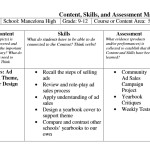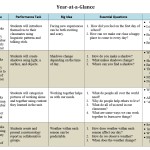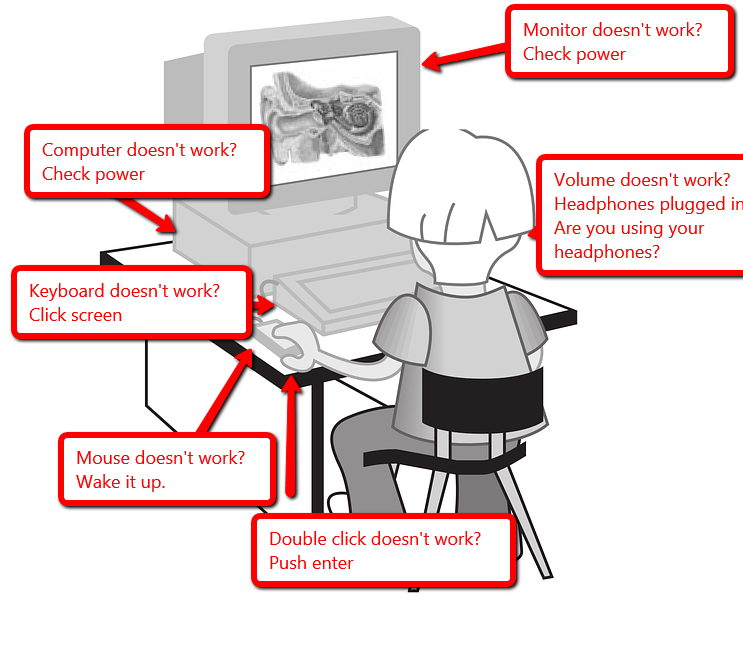 If I’m trying to get from Los Angeles, California to Minot, North Dakota, I start with a map. I build a route that includes the sights I’d like to visit, shows me the connecting roadways, and gives me a rough idea of how long it’ll take.
If I’m trying to get from Los Angeles, California to Minot, North Dakota, I start with a map. I build a route that includes the sights I’d like to visit, shows me the connecting roadways, and gives me a rough idea of how long it’ll take.
The same is true with teaching a class. I need a map to show how best to blend my curriculum and the school’s standards, scaffold skills on each other, and connect to all stakeholders involved. In education, that’s called a Curriculum Map.
What is a Curriculum Map?
According to Education World, a Curriculum Map is…
…a process for collecting and recording curriculum-related data that identifies core skills and content taught, processes employed, and assessments used for each subject area and grade level.
—Education World: Virtual Workshop: Curriculum Mapping
A Curriculum Map first and foremost is a planning tool, a procedure for examining and organizing curriculum that allows educators to determine how content, skills and assessments will unfold over the course of the year. It is an in-depth view of topics teachers will instruct over the school year, their pacing, and how they blend with other subjects. In an IB school, that includes the learner profiles that are satisfied. In a Common Core school, that covers the math and literacy standards addressed. In other states, it’ll be how lesson plans meet their unique state standards.
In general terms, a Curriculum Map includes:
- specific skills
- assessments
- essential questions
- big ideas
- accommodations
- materials required
How do you use a Curriculum Map?
A Curriculum Map doesn’t tell teachers HOW to teach, rather what needs to be taught to achieve goals. Because it’s a living document, notes added by the teacher each year address how varied student needs were accommodated within a lesson plan. These can be planned for the following year. Entries are viewable by all personnel in a school or district, likely located on a secure server that can be accessed through the internet. This allows educators to view within their grade level as well as vertically, to see if students enter the grade level with the skills required and leave the grade prepared for requirements of the next grade.
How do you create a Curriculum Map?
Curriculum mapping is a process, not a one-time initiative. It is created by the core teacher with the assistance of all other involved teachers. With this collaboration, lesson plans integrate all subjects, spiral up or down as needed, and are scalable to student needs. Key to the Map is that each teacher enters what is taught in real-time throughout the school year, in contrast to having an outside committee make teaching decisions.
A Curriculum Map can be built from a basic spreadsheet tool or a sophisticated online program like Atlas Rubicon. Whichever you pick, make sure it’s accessible from the internet and allows for online collaboration and sharing. It must become a living document that is part of the teaching process.
Here are basics:
- Start with a list of topics that will be taught that year. This is developed based on:
- teacher input–grade-level teaching team and vertically-aligned teachers
- school curriculum–the broad mission of the school. This includes criteria such as Common Core, TEKS, IB philosophy, and State Standards
- school learning philosophy–this might include a focus on citizenship, problem-solving, and the development of lifelong learners
- student needs
- past experience
- Below is my list of topics divided by Major and Minor Themes, and covering the time period of September-January, for 3rd and 4th grade. I built my Curriculum Map from this outline:
- Place the topics in the spreadsheet or online tool, sequenced throughout the ten months of the school year.
- Add events that will impact your teaching time such as school holidays, teacher conferences, professional development days, and other. This allows you to be sure you have sufficient time in the school year to complete the assigned tasks.
- Add other information that’s important to your school such as essential question, assessments, pacing, and Standards met. Here’s a screenshot of part of my spreadsheet, ready for the school year and colleague input:
- There are a lot of templates for Curriculum Maps (Google ‘Curriculum Map template‘ to see a wide variety). The one you pick must work for you, your team, and your students. Here are examples:
- A Curriculum Map isn’t completed in a sitting or a weekend. It takes a year to do it right–plan, teach with it, revise and rework. What lessons took longer than you expected? When were students not ready for the unit (maybe they required earlier scaffolding to prepare)? What events popped up (like Hour of Code in December) that you wanted to involve students in, so you ‘made a hole’ in your teaching to accommodate? What tie-ins to other subjects were too good to be passed up?
- At the end of the year, look at what you have and prepare to start over the next year.
For lots more on curriculum mapping, visit Janet Hale’s website called Curriculum Mapping 101. She has answers to just about any question you come up with. Also, visit this link for Santa Ana Unified School District’s complete collection of curriculum maps.
How do you create a Curriculum Map for your class?
More on organizing your teaching:
3 education tools you don’t want to miss
3 Classroom Management Apps You’ll Love
Tech Ed Resources for your Classroom–Organize Your Classroom
Jacqui Murray has been teaching K-18 technology for 30 years. She is the editor/author of over a hundred tech ed resources including a K-12 technology curriculum, K-8 keyboard curriculum, K-8 Digital Citizenship curriculum. She is an adjunct professor in tech ed, Master Teacher, webmaster for four blogs, an Amazon Vine Voice, CSTA presentation reviewer, freelance journalist on tech ed topics, contributor to NEA Today, and author of the tech thrillers, To Hunt a Sub and Twenty-four Days. You can find her resources at Structured Learning.











































This is a great piece about building curriculum maps, and I was excited to hear you mention Rubicon Atlas as a tool to support teachers in this process! I work as a member of the Professional Development team at Rubicon and wanted to follow up with a blog post of ours about articulating a strong curriculum mapping process by answering the ‘who, what, and why of curriculum mapping’.
Here is the post: https://www.rubicon.com/3-questions-curriculum-process/
We are excited to link to your post in the future as a great resource for teachers looking to begin a mapping process!
Thanks, Anna. I had personal experience with Rubicon and found it to be an excellent tool. Of course, I had to include it!